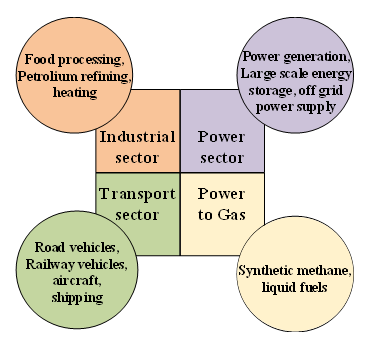Smart Hydrogen Applications in Transportation/Power Sectors
Written by Ashtabhuj Kumar Srivastava and Bhavesh R. Bhalja
With the rapid expansion in technologies related to hydrogen applications, new perceptions addressing novel technologies are approaching the market. Consequently, there is a need to keep track of global involvements and accomplishments taking place in the field of smart hydrogen in various sectors. The same is depicted in Figure 1. In the industrial segment, it is utilized as a feedstock for refining ammonia/methanol synthesis, and to reduce iron processing.
The use of hydrogen will increase in other segments as a synthetic fuel, where hydrogen will be converted from electrolytic hydrogen to aid in producing different liquid fuels as well as ammonia. Certain applications of hydrogen also come from the heating sector where high-temperature heat is required in industries and low-temperature heat is required in residential areas. The many beneficial attributes of hydrogen also allow it to be smartly used in the transportation/power sector, which is discussed in the following sections.
Figure 1: Application of Hydrogen in various sectors.
Smart Hydrogen Application in the Transportation Sector
The transportation sector is responsible for one-fifth of the world's greenhouse gas emissions and consumes 25% of all global energy [1]. Though the use of hydrogen in the transportation sector is minimal compared to diesel and gas, it could play a significant role in electrifying the transportation/power sector due to its high energy density, high efficiency, and significantly fewer carbon emissions. A comparison of hydrogen with the other two fuels in terms of energy density and cost are shown in Table I. Hybrid power trains comprising Fuel Cells (FCs) in conjunction with a battery energy storage system (BESS) can be employed to minimize the vehicles' hydrogen consumption and operating cost. Additionally, FC-based electric vehicles have the advantages of longer ranges and shorter refueling times. Hydrogen-fueled Proton Exchange Membrane Fuel Cells (PEMFCs) are widely used in vehicle applications because they produce electricity with water and heat as their byproducts without the emission of harmful gases (such as SOx, NOx, etc.). In June 2022, there were about 59,000 fuel cell powered electric vehicles on the road, with a 15% increase by the end of 2021 [2]. Nowadays, "green hydrogen" is produced by the water-splitting electrolysis method using renewable sources. Green ammonia, which is produced from green hydrogen, can be a potential alternative to power ships. In the aviation sector, synthetic jet fuel has good potential. Airbus is exploring a hydrogen-powered aircraft concept with the potential of carrying 200 passengers up to 3700 km by 2035 [3]. Using green hydrogen as a rail fuel offers a range of benefits, including supporting zero carbon goals as a clean energy source. Hydrogen FC based railway vehicles powered by PEMFC along with a battery bank are being tried out globally for powering railroad vehicles. Two trains completed more than 180000 km of travel in Germany and Austria started hydrogen-fueled passenger trains in 2020 [4]. At the same time, the United Kingdom and the Netherlands are coming up with a pilot fuel cell rail.
Table I. Energy density and cost comparison of different fuels [5]-[7].
Challenges and Probable Solutions of Hydrogen based Railway Vehicles
One of the major challenges faced by FCs includes the cost of hydrogen, which is still higher than that of conventional carbon-rich fuels. While lighter materials for compressing hydrogen at high pressures are under research and development, a locomotive's limited space and weight constraints sometimes make it not possible to store enough hydrogen to travel over a long distance. To overcome these challenges, there is a need to develop an optimal energy management system for FC-based locomotives. An energy management system (EMS), developed by authors, for FC-based hybrid energy systems (HES) applied in railway vehicles is depicted in Fig. 2. For an FC-based hybrid power train, it is necessary to design various modules such as collection and preparation of data related to the desired track and locomotive to be retrofitted.
Figure 2: EMS for Fuel Cell based HES employed in railway vehicles.
Additionally, mathematical modeling of the EMS, design, and operational constraints need to be prepared. Once the model is ready, it can be fed to an optimization module, which can be further used to achieve various goals such as optimal sizing and optimal power sharing among FC and BESS, while reducing hydrogen consumption as well as operating costs. Recent developments in the control, computing, and communication fields can be used to improve the design and energy management of FC-based hybrid power trains.
Application of Smart Hydrogen in the Power Sector
As renewable energy sources are intermittent in nature, hydrogen is utilized in gas turbines and stationary FCs. It also offers an alternative to the conventional power grid, when used with a FC, as the energy may be generated when and where it is required, negating the need for hydrogen storage. Hydrogen can be utilized for long-term, large-scale storage as well as heating, cooling, and home appliances in reducing the fluctuating output. The hydrogen fuel cell can be used in conjunction with different renewable sources like solar PV and/or wind for smart operation which in turn increases grid reliability and efficiency. During grid outages, it can be used as a backup power operation for more than a hundred hours compared to BESS because of its high energy density. The integration of FCs into microgrids has demonstrated significant benefits in increasing the efficiency of microgrids. Besides, several active initiatives can be employed for the effective integration of FCs of various power sizes into microgrids. When there is a significant demand for both electrical and thermal energy, the use of hydrogen FCs for combined heat and power (CHP) applications is also growing rapidly. The United States has installed 126 fuel cells with a combined capacity of 67 MW and an average capacity of 532 kW for CHP applications [8]. Japan aims to have 1 GW of hydrogen-based power capacity by 2030 whereas Korea aims to achieve 1.5 GW FC capacity by 2022 [9]. Further, hierarchical control may be applied for integrating hydrogen FC with different renewable sources to enhance reliability, efficiency, and economy of the grid.
References
- “Global Hydrogen Review 2021,” Int. Energy Agency, Paris, France, Tech. Rep., 2021. [Online]. Available: https://iea.blob.core.windows.net/assets/5bd46d7b-906a-4429-abda-e9c507a62341/GlobalHydrogenReview2021.pdf.
- “Global Hydrogen Review 2022,” Int. Energy Agency, Paris, France, Tech. Rep., 2022. [Online]. Available: https://iea.blob.core.windows.net/assets/c5bc75b1-9e4d-460d-9056-6e8e626a11c4/GlobalHydrogenReview2022.pdf.
- Sumit Singh. (2021, August 20). How Airbus’ Hydrogen Powered Plane Could Serve The Russian Market. Simple Flying. https://www.railway-technology.com/projects/coradia-ilint-regional-train/
- Verdict Media Limited (2021) Railway technology: cordia iLint regional train. https://www.railway-technology.com/projects/coradia-ilint-regional-train/. Accessed 20 November 2022.
- Patrick Molloy. (2019, October 2). Run on Less with Hydrogen Fuel Cells. RMI. https://rmi.org/run-on-less-with-hydrogen-fuel-cells/#:~:text=By%20contrast%2C%20hydrogen%20has%20an,12%E2%80%9314%20kWh%20per%20kg.
- Julie Cart. (2020, January 9). California’s ‘hydrogen highway’ never happened. Could 2020 change that?. CAL MATTERS. https://calmatters.org/environment/2020/01/why-california-hydrogen-cars-2020/
- “CLEAN CITIES Alternative Fuel Price Report,” U.S. DEPARTMENT OF ENERGY, Washington, October 2022. [Online]. Available: https://afdc.energy.gov/fuels/prices.html
- “Shifting energy landscape Grey to green gains pace,” Institutional Research, Mumbai, India, Tech. Rep.,2022.[Online].Available: https://www.hdfcsec.com/hsl.docs//Power%20-%20Shifting%20energy%20landscape;%20Grey%20to%20green%20gains%20pace-202206201139453034709.pdf.
- Z. Li, Z. Zheng, L. Xu, and X. Lu, “A review of the applications of fuel cells in microgrids: opportunities and challenges,” BMC Energy, vol. 1, no. 1, pp. 1–23, 2019.https://www.energy.gov/energy-storagegrand-challenge/downloads/2020-grid-energy-storage-technology-cost-and-performance.
This article was edited by Jorge Martinez.
To view all articles in this issue, please go to March 2023 eNewsletter. For a downloadable copy, please visit the IEEE Smart Cities Resource Center.








